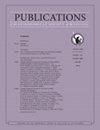附近青年协会快速指南
IF 7.7
3区 物理与天体物理
Q2 ASTRONOMY & ASTROPHYSICS
Publications of the Astronomical Society of the Pacific
Pub Date : 2024-06-11
DOI:10.1088/1538-3873/ad4e6a
引用次数: 0
摘要
邻近的共生恒星群是重要的基准实验室,因为它们能提供可靠的恒星年龄测量数据。对这类共生恒星群的研究可以通过研究恒星的初始质量函数、双星部分或星际周盘来更好地了解恒星的形成,确定最初密集的年轻恒星群是如何逐渐分散以形成场群的,并揭示恒星、系外行星和亚恒星天体的特性是如何在其生命周期中以不同的快照发生演变的。盖亚(Gaia)等大型飞行任务的出现正在重塑我们对太阳邻域及其以外地区恒星运动学的认识,并为首次探测大量松散的共生恒星联合体提供了机会,这些联合体由于密度低或成员微弱而在之前未被探测到。与此同时,系外行星和亚恒星天体探测和特征描述方面的进展也开始揭示太阳系外大气的详细特性,以及系外行星基本特性(如半径、质量和轨道参数)的群体级分布。目前还很少有精确的年龄来解释系外行星和亚恒星天体的演化过程,而这两个领域的详细年龄调查现在都已经成熟,因为我们开始发现以前未能探测到的越来越近的低密度结合体,以及系外行星和更遥远的疏散星团和恒星形成区中质量越来越低的成员。在本文中,我们将回顾最近在识别和描述近邻星团方面取得的一些进展,测量恒星年龄的方法,以及年轻星团研究的一些直接应用,如新出现的孤立行星质量天体领域。本文章由计算机程序翻译,如有差异,请以英文原文为准。
A Quick Guide to Nearby Young Associations
Nearby associations of stars which are coeval are important benchmark laboratories because they provide robust measurements of stellar ages. The study of such coeval groups makes it possible to better understand star formation by studying the initial mass function, the binary fraction or the circumstellar disks of stars, to determine how the initially dense populations of young stars gradually disperse to form the field population, and to shed light on how the properties of stars, exoplanets and substellar objects evolve with distinct snapshots along their lifetime. The advent of large-scale missions such as Gaia is reshaping our understanding or stellar kinematics in the Solar neighborhood and beyond, and offers the opportunity to detect a large number of loose, coeval stellar associations for the first time, which evaded prior detection because of their low density or the faintness of their members. In parallel, advances in detection and characterization of exoplanets and substellar objects are starting to unveil the detailed properties of extrasolar atmospheres, as well as population-level distributions in fundamental exoplanet properties such as radii, masses, and orbital parameters. Accurate ages are still sparsely available to interpret the evolution of both exoplanets and substellar objects, and both fields are now ripe for detailed age investigations because we are starting to uncover ever-closer low-density associations that previously escaped detection, as well as exoplanets and ever lower-mass members of more distant open clusters and star-forming regions. In this paper, we review some recent advances in the identification and characterization of nearby associations, the methods by which stellar ages are measured, and some of the direct applications of the study of young associations such as the emergent field of isolated planetary-mass objects.
求助全文
通过发布文献求助,成功后即可免费获取论文全文。
去求助
来源期刊
CiteScore
6.70
自引率
5.70%
发文量
103
审稿时长
4-8 weeks
期刊介绍:
The Publications of the Astronomical Society of the Pacific (PASP), the technical journal of the Astronomical Society of the Pacific (ASP), has been published regularly since 1889, and is an integral part of the ASP''s mission to advance the science of astronomy and disseminate astronomical information. The journal provides an outlet for astronomical results of a scientific nature and serves to keep readers in touch with current astronomical research. It contains refereed research and instrumentation articles, invited and contributed reviews, tutorials, and dissertation summaries.

 求助内容:
求助内容: 应助结果提醒方式:
应助结果提醒方式:


